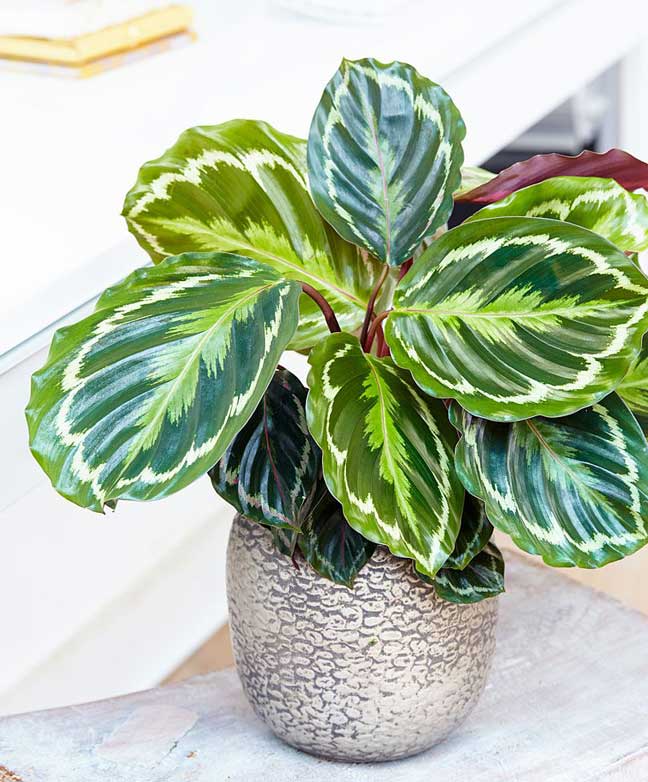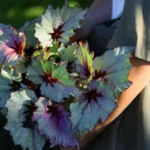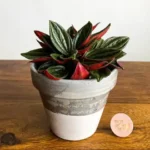Understanding Calathea Medallion: A Living Work of Art
Calathea medallion is a striking houseplant renowned for its ornate foliage. With bold, oval-shaped leaves patterned in shades of rich green, silver, and purple undersides, it resembles a decorative painting from nature. It’s part of the Marantaceae family, often referred to as prayer plants due to their rhythmic circadian movements—folding up at night and unfurling by morning. These movements make Calathea medallion not just a beautiful plant to observe but an interactive one as well.
Native to the tropical rainforests of South America, especially Brazil, Calathea medallion thrives in warm, humid environments. This makes it ideally suited to indoor growing when provided the right care. While it may be a bit finicky for beginners, understanding its needs can turn your space into a lush, living oasis.
Lighting Needs
Calathea medallion does best in medium to bright, indirect light. Direct sunlight can scorch its intricate foliage, causing the leaves to fade or develop brown patches. On the other hand, very low light can slow growth and cause the plant to lose its vibrancy.
- Ideal Location: A spot near a north or east-facing window is ideal, or use sheer curtains in brighter rooms to diffuse strong light.
- Artificial Lighting: If natural light is limited, fluorescent or full-spectrum grow lights can supplement light needs effectively.
Watering Requirements
Watering Calathea medallion properly is key to maintaining its health. These plants prefer consistently moist, but not soggy soil. Overwatering or allowing the plant to sit in water can lead to root rot, while underwatering will cause leaf curling and browning.
- Water Type: Use filtered or distilled water whenever possible. Tap water often contains salts, chlorine, or fluoride, which can damage the leaves.
- Watering Routine: Water when the top 1 inch of soil feels dry. In general, this means once every 5–7 days, depending on your indoor climate.
- Tip: Reduce watering slightly in the winter months when the plant enters a period of slower growth.
Humidity and Temperature
As a tropical plant, Calathea medallion is highly sensitive to dry air and extreme temperatures. It flourishes in a warm, humid environment and gets stressed quickly in dry indoor settings, especially during winter.
- Temperature Range: Optimal temperature is between 65–80°F (18–27°C). Avoid cold drafts and sudden temperature changes.
- Humidity Needs: Aim for 50–60% humidity or higher. If your home is dry:
- Use a humidifier near the plant
- Group it with other humidity-loving plants
- Place the pot on a tray filled with water and pebbles (ensure the pot isn’t touching the water directly)
- Mist the leaves with distilled water a few times a week
Soil and Repotting
Choosing the right soil mix is crucial for Calathea medallion’s root health. It needs a medium that retains some moisture but also has excellent drainage.
- Soil Mix: Use a blend that includes peat moss or coco coir, perlite, and a bit of orchid bark for airflow.
- Repotting: Repot every 1–2 years in the spring to refresh the soil and check for root health. Choose a pot that is 1–2 inches larger in diameter than the current one and always has drainage holes.
Fertilizing
Feeding your Calathea medallion encourages new growth and helps maintain vibrant leaf patterns. However, too much fertilizer can lead to salt buildup in the soil, which can damage roots.
- Type of Fertilizer: Use a balanced, water-soluble houseplant fertilizer diluted to half strength.
- Fertilizing Schedule: Feed monthly during the growing season (spring through summer). Avoid fertilizing in late fall and winter when growth slows.
Pruning and Maintenance
Calathea medallion doesn’t require significant pruning, but regular maintenance keeps it looking its best.
- Remove any yellowing or dried-out leaves using clean, sharp scissors
- Wipe the leaves occasionally with a damp cloth to remove dust and enhance photosynthesis
- Check regularly for pests like spider mites or fungus gnats, especially in drier conditions
If pest issues arise, neem oil sprays or insecticidal soaps can usually resolve the problem when applied consistently.
Common Issues and Solutions
Even with solid care routines, Calathea medallion may show signs of stress. The key is recognizing the symptoms early and adjusting care accordingly.
- Leaf Curling: Often a sign of low humidity or underwatering. Mist more frequently and reassess watering schedule.
- Brown Leaf Edges: This usually points to dry air, tap water sensitivities, or too much fertilizer. Switch to filtered water and increase humidity.
- Faded Leaves: Too much sunlight can bleach the leaf patterns. Move the plant to a spot with indirect light.
Propagation Tips
Calathea medallion is best propagated by division rather than stem or leaf cuttings. This makes propagation a less frequent endeavor but very successful when done properly.
- Best Time: During repotting in spring or early summer
- Method: Gently separate a cluster of stems with roots intact from the mother plant, and pot it in its new container with fresh soil
Water well after dividing and keep the new plant in a warm, humid space for several weeks to encourage acclimation.
Why Grow a Calathea Medallion?
In addition to its breathtaking foliage, Calathea medallion is non-toxic to pets, making it a safe choice for households with curious cats or dogs. It also improves indoor air quality, contributing to a fresher, greener home environment. For plant enthusiasts looking to expand their collection with a showstopper species, the Calathea medallion offers both beauty and interaction—from its striking leaf patterns to its daily prayer movements.
Conclusion: Embrace the Beauty and Challenge
Caring for a Calathea medallion can be a gratifying experience once its needs are understood and met consistently. While it may require more attention than your average pothos or snake plant, the reward is a lush, living piece of art that becomes a focal point of any indoor garden. With proper lighting, humidity, and care, your Calathea will thrive and become a lasting part of your botanical family.
As with all houseplants, patience and observation are key. Keep an eye on how your Calathea responds to its environment, and adjust your care accordingly. It may take some time to perfect the routine, but seeing those bold, broad leaves unfurl is a joy well worth the effort.
References
- Leopold, A. C., & Kriedemann, P. E. (2020). Plant Growth and Development. Springer.
- Ferris, P. (2021). The House Plant Expert (Rev. ed.). Transworld Publishers.
- National Gardening Association. (2023). Calathea Care Guide. Retrieved from https://garden.org/plants/view/11736/Calathea








